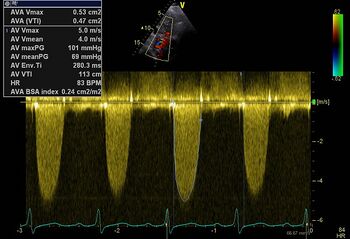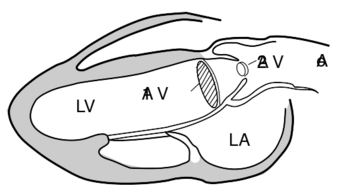Aortic Valve Stenosis: Difference between revisions
No edit summary |
No edit summary |
||
| (3 intermediate revisions by one other user not shown) | |||
| Line 37: | Line 37: | ||
|<0.60cm<sup>2</sup>/m<sup>2</sup> | |<0.60cm<sup>2</sup>/m<sup>2</sup> | ||
|} | |} | ||
{| class="wikitable" cellpadding="0" cellspacing="0" border="0" | |||
|- | |||
|[[Image:AoScw03.jpg|350px]] | |||
|Video | |||
|- | |||
!Serious AoS: PG max 101mmHg, PG mean 69mmHg<cite>1</cite> | |||
!PHT moderate Aol <cite>1</cite> | |||
|- | |||
|colspan="2"|Click [http://www.csecho.ca/cardiomath/?eqnHD=echo&eqnDisp=avavti '''here'''] to calculate AGM | |||
|} | |||
==Aortic valve area (AVA)== | |||
For the calculation of the aortic valve surface, the continuity equation can be applied. | |||
{| class="wikitable" cellpadding="0" cellspacing="0" border="0" | |||
|- | |||
|colspan="2"|'''Continuity equation:''' A1.v1 = A2.v2 | |||
|- | |||
|[[Image:Continuty_equation.svg|350px]] | |||
|valign="top" bgcolor="FFFFFF"| | |||
:'''Where:''' A=area (∏r<sup>2</sup>) cm<sup>2</sup> | |||
:v=velocity, cm/s (can be used as maximum speed or TVI) | |||
|- | |||
|colspan="2"|'''so:''' | |||
Aortic valve area (AVA)=( D LVOT/2 )<sup>2</sup> x 3:14 x Vmax LVOT/Vmax peak in AoS jet | |||
'''Where:''' D LVOT=diameter LVOT in cm | |||
|} | |||
==Dimensionless index (DI)== | |||
If you are unable to get a good measurement of the LVOT can also the ratio of the velocity in the LVOT and the speed of the aortic valve to give a good impression about the severity of aortic stenosis . | |||
DI = V LVOT/V aorta | |||
In a DI ≤25, there is almost always a severe aortic valve stenosis . | |||
==Low-gradient aortic stenosis vs . Pseudo stenosis== | |||
In an aortic valve stenosis with a low gradient (< 30 mmHg), and poor left ventricular function is to be a valve surface calculated . If an AVA <1 cm<sup>2</sup> is calculated can be a severe aortic valve stenosis are present despite the low gradient. However, it could also be that the valve does not open properly due to low cardiac output (pseudo stenosis). To gain more insight into the aortic valve or a "true" or stenosis has a "pseudo stenosis" seems dobutamine stress worthwhile. If during dobutamine infusion up to 20 μg/kg there is an increase of more than 20% in the VTI of the LVOT (ie cardiac output ) and the calculated valve area remains below 1 cm<sup>2</sup> then there is a true aortic stenosis . If not , and there appears to be a contractile reserve (which is predictive of a better prognosis after aortic valve replacement ) it is called a pseudo stenosis. | |||
==References== | |||
<biblio> | |||
#1 pmid=19065003 | |||
</biblio> | |||
Latest revision as of 20:16, 29 December 2013
Aortic stenosis quantification
| Slight | Moderate | Severe | |
|---|---|---|---|
| PG max | 15-40 mmHg | 40-70 mmHg | 70-100 mmHg (> 100 mmHg severe AoS) |
| PG mean | <20mmHg | 20-40mmHg> | 40mmHg |
| AVA> | 1.5cm2 | 1.5-1cm2 | <1cm2 |
| Dimensionless index> | 0.50 | 0.25 to 0.50 | <0.25 |
| Vmax | <3m/s | 3-4m/s | >4m/s |
| AVA BSAindex | >0.85cm2/m2 | 0.85-0.60cm2/m2 | <0.60cm2/m2 |

|
Video |
| Serious AoS: PG max 101mmHg, PG mean 69mmHg1 | PHT moderate Aol 1 |
|---|---|
| Click here to calculate AGM | |
Aortic valve area (AVA)
For the calculation of the aortic valve surface, the continuity equation can be applied.
Dimensionless index (DI)
If you are unable to get a good measurement of the LVOT can also the ratio of the velocity in the LVOT and the speed of the aortic valve to give a good impression about the severity of aortic stenosis .
DI = V LVOT/V aorta
In a DI ≤25, there is almost always a severe aortic valve stenosis .
Low-gradient aortic stenosis vs . Pseudo stenosis
In an aortic valve stenosis with a low gradient (< 30 mmHg), and poor left ventricular function is to be a valve surface calculated . If an AVA <1 cm2 is calculated can be a severe aortic valve stenosis are present despite the low gradient. However, it could also be that the valve does not open properly due to low cardiac output (pseudo stenosis). To gain more insight into the aortic valve or a "true" or stenosis has a "pseudo stenosis" seems dobutamine stress worthwhile. If during dobutamine infusion up to 20 μg/kg there is an increase of more than 20% in the VTI of the LVOT (ie cardiac output ) and the calculated valve area remains below 1 cm2 then there is a true aortic stenosis . If not , and there appears to be a contractile reserve (which is predictive of a better prognosis after aortic valve replacement ) it is called a pseudo stenosis.
References
<biblio>
- 1 pmid=19065003
</biblio>
